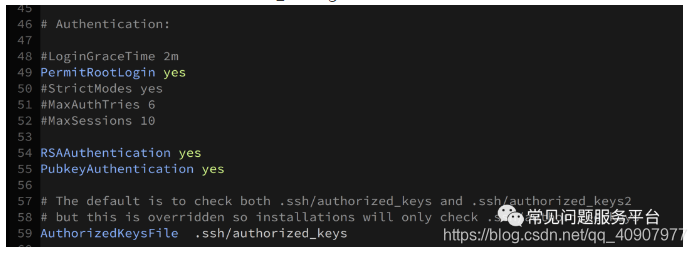CentOS下openssh版本降级
本文共 746 字,大约阅读时间需要 2 分钟。
1.卸载openssh
执行rpm-qaopenssh* 查看是否已经安装过了。
[root@node51 ~]# rpm-qaopenssh*openssh-server-6.6.1p1-11.el7.x86_64openssh-6.6.1p1-11.el7.x86_64openssh-clients-6.6.1p1-11.el7.x86_64
依次卸载:
[root@node51 ~]# yum remove openssh-server-6.6.1p1-11.el7.x86_64[root@node51 ~]# yum remove openssh-clients-6.6.1p1-11.el7.x86_64[root@node51 ~]# yum remove openssh-6.6.1p1-11.el7.x86_64
或者使用:yum remove openssh-* 全部卸载掉
2.安装openssh
yum install -y openssl openssh-server
用vim打开配置文件/etc/ssh/sshd_config

把上图的PermitRootLogin,RSAAuthentication,PubkeyAuthentication的设置打开。
执行 systemctlstart sshd.service 启动服务
设置开机自启动:systemctl enable sshd.service
参考:https://www.cnblogs.com/liuhouhou/p/8975812.html
参考链接:
CentOS下openssh版本降级 https://mp.weixin.qq.com/s/GM8aMhTesD9ERGNKq8iIkg
你可能感兴趣的文章
Nacos Config--服务配置
查看>>
Nacos Derby 远程命令执行漏洞(QVD-2024-26473)
查看>>
Nacos 与 Eureka、Zookeeper 和 Consul 等其他注册中心的区别
查看>>
Nacos 单机集群搭建及常用生产环境配置 | Spring Cloud 3
查看>>
Nacos 启动报错[db-load-error]load jdbc.properties error
查看>>
Nacos 注册服务源码分析
查看>>
Nacos 融合 Spring Cloud,成为注册配置中心
查看>>
Nacos-注册中心
查看>>
Nacos2.X 源码分析:为订阅方推送、服务健康检查、集群数据同步、grpc客户端服务端初始化
查看>>
Nacos2.X 配置中心源码分析:客户端如何拉取配置、服务端配置发布客户端监听机制
查看>>
Nacos2.X源码分析:服务注册、服务发现流程
查看>>
NacosClient客户端搭建,微服务注册进nacos
查看>>
Nacos中使用ribbon
查看>>
Nacos使用OpenFeign
查看>>
Nacos使用Ribbon
查看>>
Nacos做注册中心使用
查看>>
Nacos做配置中心使用
查看>>
Nacos入门过程的坑--获取不到配置的值
查看>>
Nacos原理
查看>>
Nacos发布0.5.0版本,轻松玩转动态 DNS 服务
查看>>